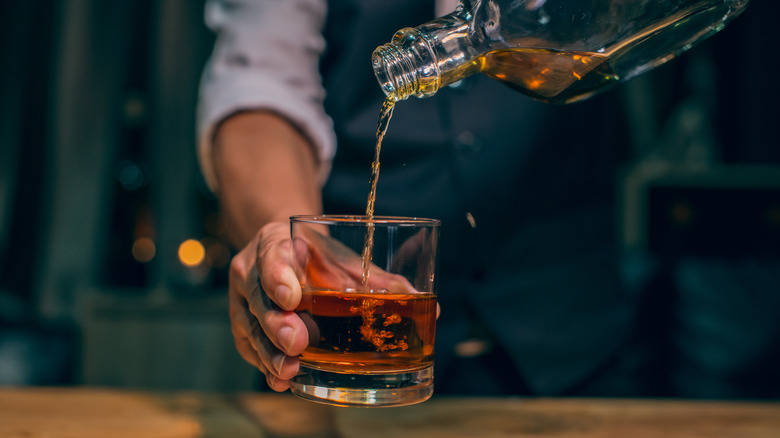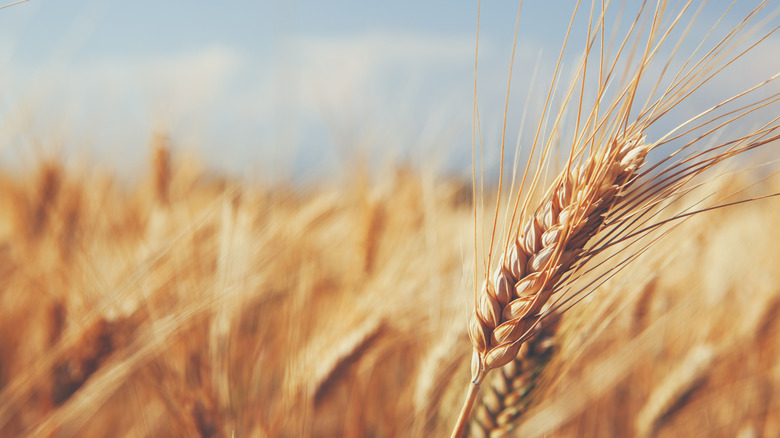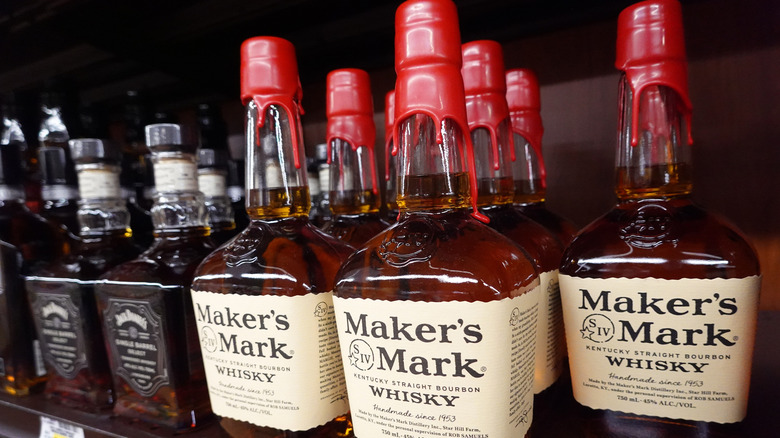What Is Wheated Bourbon, And Why Isn't It Clearly Labeled?
What do popular bourbons made by Maker's Mark and Pappy Van Winkle have in common? They both fall into the category of wheated bourbon. The mash bills (or mixture of grains) used to distill these sought-after labels contain a larger percentage of wheat, which can have a huge positive impact on the drink's flavor. Despite this, not a lot of brands brag about this trait — you may have never seen the term "wheated bourbon" on a bottle, because distillers aren't required by law to put it there.
Knowing this, wheated bourbon might seem mysterious, but it's easy to understand. For an American whiskey (not a whisky) to be labeled as bourbon, corn must be the dominant grain, accounting for more than 51% of the mash bill by law. The remainder of the recipe consists of grains like rye, barley, and wheat, in any proportion the distiller chooses. Malted barley is typically used to assist the fermentation process, while wheat and rye are "flavoring grains" that influence the bourbon's taste, with the former adding sweetness and the latter adding spice.
As you might imagine, wheated bourbons are on the sweeter, easy-drinking side. Though most labels only contain about 20% wheat, that portion of the mash bill characterizes some of the smoothest labels around. If you're eager to seek some of these bottles out, it's possible that some bourbons you already love are wheated, and you didn't even know it. After all, the style has a long and proud history.
The history of wheated bourbon
Wheated bourbon goes back to the middle of the 19th century. William Larue Weller of famous Maryland distilling company W.L. Weller & Sons is commonly credited for pioneering the style. Before his innovation, rye was the go-to complement to the corn and malted barley in bourbon. Companies in Kentucky, Maryland, and Pennsylvania preferred the crop thanks to its hardier, blight-resistant qualities. Wheat only emerged as a flavoring grain once distillers decided to seek new ways to distinguish their products.
Using rye or wheat in bourbon isn't an either-or proposition. Some distillers use both to create flavor profiles with both sweetness and spice. In wheated bourbon, however, rye is either left out or used in a lower percentage. The resulting flavor is more mellow than bourbons or whiskeys made with rye, with a smooth, rounded mouthfeel and sweeter flavor notes like butterscotch, caramel, and honey.
This style of bourbon has become increasingly popular, but not a lot of brands openly label themselves as wheated. If brands don't want to fit the words "wheated bourbon" onto their label designs — or prefer to be more mysterious about the main source of their bourbon's flavor — they're not required to use the term. However, it's easy to tell if a brand is wheated just by the taste, and learning to recognize the signs can help you buy bourbon like a pro.
Brands known for making wheated bourbon
Mellow, smooth, and sweet bourbon brands often contain a good amount of wheat. Maker's Mark has been making wheated bourbons since the 1950s. The distillery's founder, Bill Samuels Sr., created his own special mash bill through trial and error. The resulting blend features 16% red winter wheat, a slightly lower percentage than is used by most wheated bourbon producers. Maker's Mark Original delivers notes of sweet oak, vanilla, and fruity notes from its wheated formula.
The famously expensive Pappy Van Winkle bourbons are estimated to include 15% to 17% wheat, the same as W.L. Weller bourbons. Additionally, both brands are made at Buffalo Trace Distillery. The formula behind these legendary bourbons has not been publicly divulged, so the percentages of corn, wheat, and malted barley can only be guessed at by bourbon aficionados. Pappy Van Winkle's many labels, from its 10-year bottles to its 23-year variety, share notes of smooth vanilla, oak, honey, caramel, and fruit.
Similar mash bills are a common occurrence in this smaller category of bourbons. Kentucky-made Rebel Yell, for example, favors a recipe with 20% wheat, 68% corn, and 12% malted barley. That's the same amount of wheat used by Old Fitzgerald, another highly-respected wheated bourbon brand, and by Larceny, a newer label on the block that was inspired by Old Fitzgerald.



